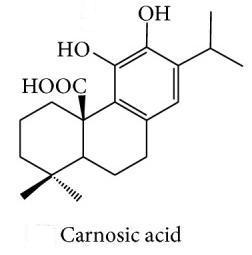博文
迷迭香化合物有望逆转阿尔茨海默氏症的记忆丧失
 精选
精选
||
迷迭香化合物有望逆转阿尔茨海默氏症的记忆丧失
诸平
据美国斯克里普斯研究所(Scripps Research Institute简称Scripps Research)2025年3月12日提供的消息,迷迭香化合物有望逆转阿尔茨海默氏症的记忆丧失(Rosemary Compound Shows Promise in Reversing Alzheimer’s Memory Loss)。
Fig. 3 Carnosic Acid
斯克里普斯研究所的科学家们开发了一种稳定的鼠尾草酸(carnosic acid),可以增强老鼠的记忆功能,改善疾病相关症状。(Scientists at Scripps Research developed a stable form of carnosic acid, which enhanced memory function and improved disease-related symptoms in mice.)
迷迭香{rosemary (Rosmarinus officinalis)}一直与记忆联系在一起。莎士比亚(Shakespeare)的《哈姆雷特》(Hamlet)中的奥菲莉亚(Ophelia)说:“迷迭香是用来记忆的。”研究人员对迷迭香和鼠尾草(rosemary and sage)的研究,发现了一种对阿尔茨海默病(Alzheimer’s disease)有潜在影响的化合物——鼠尾草酸(carnosic acid)。这种疾病是痴呆症的主要原因,也是美国第六大死亡原因,通常伴有炎症,这会导致认知能力下降。
鼠尾草酸是一种抗氧化剂和抗炎化合物,可以激活形成人体自然防御系统的酶。然而,纯鼠尾草酸太不稳定,不能用作药物。为了解决这个问题,斯克里普斯研究所(Scripps Research)的科学家们合成了一种叫做diAcCA的稳定形式,它在被吸收到血液中之前,在肠道中完全转化为鼠尾草酸。
该研究结果于2025年2月27日已经在《抗氧化剂》(Antioxidants)杂志网站发表——Piu Banerjee, Yubo Wang, Lauren N. Carnevale, Parth Patel, Charlene K Raspur, Nancy Tran, Xu Zhang, Ravi Natarajan, Amanda J. Roberts, Phil S. Baran, Stuart A. Lipton. diAcCA, a Pro-Drug for Carnosic Acid That Activates the Nrf2 Transcriptional Pathway, Shows Efficacy in the 5xFAD Transgenic Mouse Model of Alzheimer’s Disease. Antioxidants, 2025, 14(3), 293. DOI: 10.3390/antiox14030293. Epub: 27 February 2025. https://doi.org/10.3390/antiox14030293.
参与此项研究的除了来自美国斯克里普斯研究所(Neurodegeneration New Medicines Center, Department of Molecular & Cellular Biology, The Scripps Research Institute, La Jolla, CA, USA; Behavioral Core, The Scripps Research Institute, La Jolla, CA, USA; Department of Chemistry, The Scripps Research Institute, La Jolla, CA, USA)的研究人员之外,还有来自美国加州卡马里洛的苏格拉底生物科学公司(Socrates Biosciences, Inc., Camarillo, CA, USA)、美国加州大学圣地亚哥分校(Department of Neurosciences, School of Medicine, University of California, San Diego, CA, USA)的研究人员。
该研究表明,当diAcCA用于治疗阿尔茨海默病的小鼠模型时,它在大脑中达到了治疗剂量的鼠尾草酸,并导致大脑中记忆和突触密度的增强,或更多的突触(代表神经细胞之间的连接)。因为神经元突触的减少也与阿尔茨海默病中的痴呆密切相关,这种方法可以抵消认知能力下降的进展。
减少脑部炎症,增强突触密度(Reducing Brain Inflammation and Enhancing Synaptic Density)
对组织样本的分析显示,该药还能显著减少脑部炎症。这种独特的药物是由它所对抗的炎症激活的,因此只在大脑遭受炎症损伤的区域起作用。这种选择性限制了鼠尾草酸的潜在副作用,鼠尾草酸被列入美国食品和药物管理局(US Food and Drug Administration简称FDA)公认的安全(“generally regarded as safe”简称GRAS)名单,为临床试验铺平了道路。
上述研究论文的通讯作者、斯克里普斯研究所斯德普家族基金会主席(Step Family Foundation Endowed Chair at Scripps Research)、美国加州拉霍亚的临床神经学家斯图尔特·利普顿教授(professor Stuart Lipton)说:“通过用这种diAcCA化合物对抗炎症和氧化应激,我们实际上增加了大脑中突触的数量。我们还研究了其他错误折叠或聚集的蛋白质,如磷酸化的tau蛋白(phosphorylated-tau)和淀粉样蛋白-β(amyloid-β),这些蛋白质被认为会引发阿尔茨海默病,并作为疾病过程的生物标志物。”
斯图尔特·利普顿的研究小组此前已经确定,鼠尾草酸会穿过血脑屏障,激活Nrf2转录途径(Nrf2 transcriptional pathway),从而开启抗氧化和抗炎基因。但是这种化合物很容易氧化,由于其保质期短,不适合作为药物使用。
在这项新研究中,斯图尔特·利普顿和共同作者菲尔·巴兰(Phil S. Baran)博士合成了一系列鼠尾草酸衍生物,并选择diAcCA作为最佳候选者,因为它具有稳定性,生物利用度和其他类药特性。斯图尔特·利普顿的研究小组随后用这种化合物对小鼠模型进行了三个月的治疗。研究小组通过在行为测试中测试老鼠的空间学习和记忆能力,然后在显微镜下分析它们的脑组织。
斯图尔特·利普顿说:“我们做了多种不同的记忆测试,这些测试都在服用这种药物后得到了改善。它不仅减缓了衰退;它几乎恢复了正常。组织分析还显示神经元突触密度增加,磷酸化tau聚集体(phosphorylated-tau aggregates)和淀粉样β斑块(amyloid-β plaques)的形成减少。”
安全性和潜在应用(Safety and Potential Applications)
小鼠对diAcCA耐受良好。在毒性研究中,当这种化合物转化为鼠尾草酸(carnosic acid)时,它甚至可以缓解食道和胃的基本炎症。
研究小组还发现,老鼠在摄入diAcCA后摄入的鼠尾草酸比服用普通鼠尾草酸后摄入的鼠尾草酸多20%。斯图尔特·利普顿解释说,因为大多数鼠尾草酸在储存或摄入时被氧化,故“diAcCA在血液中产生的鼠尾草酸比服用鼠尾草酸本身产生的更多。”
斯图尔特·利普顿认为,diAcCA有可能与目前市场上的阿尔茨海默病治疗方法协同工作。他说,这种药物不仅可以通过自身对抗炎症发挥作用,而且“可以通过消除或限制淀粉样蛋白抗体治疗的副作用,”如被称为ARIA-E和ARIA-H的脑肿胀或出血,使现有的淀粉样蛋白抗体治疗效果更好。
斯图尔特·利普顿希望diAcCA能够快速通过临床试验,因为它的安全性。他认为,它也可以用于治疗其他以炎症为特征的疾病,如2型糖尿病、心脏病和其他形式的神经退行性疾病,如帕金森病(Parkinson’s disease)。
本研究得到了美国国立卫生研究院{National Institutes of Health (U01 AG088679, R01 AG056259, R35 AG071734, RF1 AG057409, R01 AG056259, R56 AG065372, R01 DA048882, DP1 DA041722 and S10 OD030332)}的资助。
上述介绍仅供参考,欲了解更多信息敬请注意浏览原文和相关报道。
Jenny Lehmann. Rosemary and Sage Could Lead to Better Alzheimer’s Treatment. Mar 13, 2025
Scripps Research. Compound found in common herbs inspires potential anti-inflammatory drug for Alzheimer’s disease. March 10, 2025
The antioxidant/anti-inflammatory compound carnosic acid (CA) is a phenolic diterpene found in the herbs rosemary and sage. Upon activation, CA manifests electrophilic properties to stimulate the Nrf2 transcriptional pathway via reaction with Keap1. However, purified CA is readily oxidized and thus highly unstable. To develop CA as an Alzheimer’s disease (AD) therapeutic, we synthesized pro-drug derivatives, among which the di-acetylated form (diAcCA) showed excellent drug-like properties. diAcCA converted to CA in the stomach prior to absorption into the bloodstream, and exhibited improved stability and bioavailability as well as comparable pharmacokinetics (PK) and efficacy to CA. To test the efficacy of diAcCA in AD transgenic mice, 5xFAD mice (or littermate controls) received the drug for 3 months, followed by behavioral and immunohistochemical studies. Notably, in addition to amyloid plaques and tau tangles, a hallmark of human AD is synapse loss, a major correlate to cognitive decline. The 5xFAD animals receiving diAcCA displayed synaptic rescue on immunohistochemical analysis accompanied by improved learning and memory in the water maze test. Treatment with diAcCA reduced astrocytic and microglial inflammation, amyloid plaque formation, and phospho-tau neuritic aggregates. In toxicity studies, diAcCA was as safe or safer than CA, which is listed by the FDA as “generally regarded as safe”, indicating diAcCA is suitable for human clinical trials in AD.
https://wap.sciencenet.cn/blog-212210-1477338.html
上一篇:免疫反应可能被用于控制艾滋病毒
下一篇:喝酒可能会增加患癌症的风险



